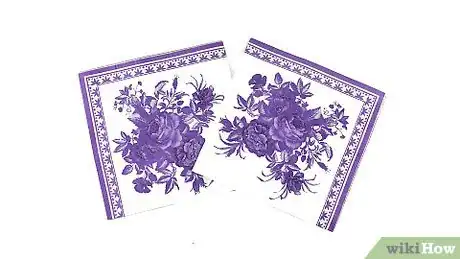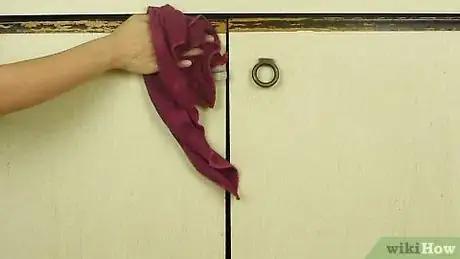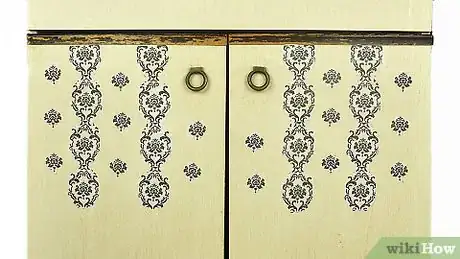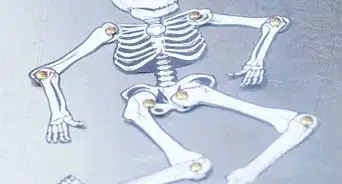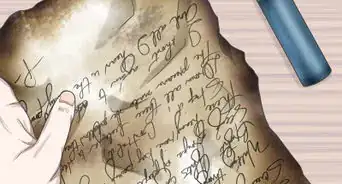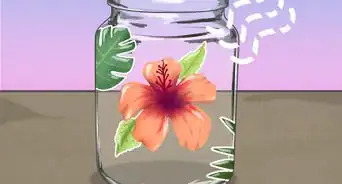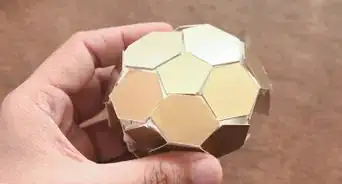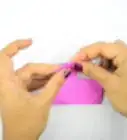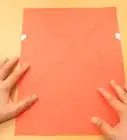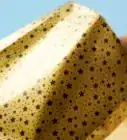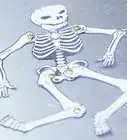This article was co-authored by Amy Guerrero and by wikiHow staff writer, Jessica Gibson. Amy Guerrero is an Arts and Crafts Specialist and the Owner of Sunshine Craft Co., a crafting studio based in Phoenix, Arizona. Amy specializes in macrame, DIY crafting, and teaching fiber arts. She offers monthly in-person and online workshops along with having developed a range of DIY craft kits for at-home projects. Amy holds a BS in Industrial Design from Philadelphia University. She worked as a graphic designer before starting her own business. Sunshine Craft Co. is a creative hub that offers a wide range of workshops, tools, and resources for any craft project to inspire creativity and community engagement.
wikiHow marks an article as reader-approved once it receives enough positive feedback. This article received 38 testimonials and 86% of readers who voted found it helpful, earning it our reader-approved status.
This article has been viewed 1,715,396 times.
If you'd like to give new life to a piece of furniture or household object, decoupage it! Choose decorative paper or thin fabric and cut or tear it. Then use a clear-drying glue to apply the material to your clean surface. Let it dry and cover the entire piece with more glue. Once you've gotten the hang of this fun craft, try your hand at decoupaging wooden furniture or terra cotta pots for the garden.
Steps
Trying Basic Decoupage
-
1Cover your workspace with paper to protect it from messes. Lay down several sheets of newspapers or an old cloth. This will prevent damage to your work surface and make cleanup easier.
- You may also want to put on an old t-shirt or an apron to protect your clothes.
-
2Choose the material you want to apply. You can use almost any paper or light fabric material to cover your surface.[1] Wrapping or origami papers are great because they're decorative and a good weight. Other types of material for decoupage include:[2]
- Wallpaper
- Magazines or catalogues
- Greeting cards
- Fabric or paper napkins
- Pages from old books
EXPERT TIPJoy Cho is the Founder and Creative Director of the lifestyle brand and design studio, Oh Joy!, founded in 2005 and based in Los Angeles, California. She has authored six books and consulted for creative businesses around the world. Joy has lectured on business, leadership, and entrepreneurship at conferences and companies such as AltSummit, Pinterest, Target, and Hallmark, while her home and studio have been featured in magazines such as House Beautiful, Parents, and Domino. She has also been named one of Time's 30 Most Influential People on the Internet multiple times and has the most followed account on Pinterest with more than 14 million followers.Designer & Style Expert, Oh Joy!
 Joy Cho
Joy Cho
Designer & Style Expert, Oh Joy!Our Expert Agrees. A great way to decoupage is using extra wrapping paper or other decorative papers that you love and have extra. You can try using a single image, like a flower from a section of wrapping paper, or rip pieces of colored tissue paper and layer them together on your surface.
Advertisement -
3Select the surface you want to decoupage. You probably already have a good idea of the item you want to decoupage. For example, you might want to update a chair, mirror, or box. You can decoupage onto wood, metal, glass, or ceramic. Consider decoupaging:[3]
- Vases or pots
- Plates, trays, mugs, or bowls
- Lamps and lampshades
- Frames
- Hardcover book
- Glass or plastic bottles
-
4Tear or cut the material to fit on the surface of your object. Use sharp scissors or a craft knife to cut the paper or fabric into shapes or an outline. If you'd like a rustic look, tear the material so it has rough edges. Decide if you'd like to place just a few pieces of material or if you'd like to overlap several pieces.
- For example, if you're covering a dresser, you may just want to cut 3 large pieces of paper that fit 3 drawers perfectly. If you're decoupaging a small box, you might want to rip a variety of materials and overlap them on all sides of the box.
-
5Pour a little glue in a small dish to use as an adhesive and varnish. Go to a craft supply store or purchase decoupage glue online. If you'd rather buy just glue, choose PVA glue since it will dry clear. Pour a small amount into a dish and set it on your work surface.[4]
- If you prefer, use a glue to make the decoupaged item and then apply a standard varnish later.
- You may be able to use a spray glue, if you can find one that dries clear.
-
6Dip a brush into the glue and apply the material to the surface.[5] Dip a small paint brush or a larger foam brush into the glue in the dish. If you're decoupaging a small item, brush the glue onto the back of the material and press the piece onto the object. If you're decoupaging a large object, use the brush to spread the glue directly onto the object.
- For example, brush the glue onto an entire dresser draw and then quickly press the material onto the glued surface.
-
7Dry the item and varnish it if you'd like to protect it. Leave the item in a well-ventilated space and let it dry completely before you use it. If you'd like to protect the item from peeling and give a slight gloss, spread another layer of glue across the entire surface and let it dry.[6]
- You can buy a varnish that dries clear, matte, or glossy.
Decoupaging Wooden Furniture
-
1Sand and fill in any holes if you plan to stain or paint the furniture. If you'd like to refinish the furniture before you decoupage, remove the hardware such as the handles and lightly sand the furniture with medium-grit sandpaper. Wipe away the dust and fill any holes with wood filler. Let the filler dry and sand it to smooth any bumps.[7]
- Wipe the dust away each time you sand the furniture.
-
2Apply primer or paint if you want to refinish the furniture. To change the look of the furniture before you decoupage, apply a primer and let it dry. Then apply your choice of paint. While you should avoid latex paint because it will bubble and blister when you decoupage, you can use:
- Acrylic paint
- Chalk paint
- Spray paint
- Watercolors
- Waterbase stain
-
3Clean and dry the furniture. If you've painted the furniture, let it dry for at least 24 hours before you begin. If you're not painting it, wipe the furniture clean with warm, soapy water. Then let it dry completely.[8]
-
4Cut out or tear the material you want to apply. Use scissors or the craft knife to cut out the paper or fabric you're going to decoupage onto the furniture.
- For example, if you're decoupaging a dresser, you could cut long strips of wallpaper or tear smaller pieces of book pages.
-
5Decide where you'll place the material. If you're decoupaging a large piece of furniture, it's a good idea to plan where the pieces of paper or fabric will go. Consider laying them out so you can see if you like where they're positioned before you glue them to the furniture.[9]
- You might not need a plan if you're decoupaging 1 or 2 large pieces, but it's helpful if you'll be making a patchwork effect with lots of smaller pieces.
-
6Spread the glue onto part of the furniture and apply the material. Dip a paint brush or foam brush into your glue and spread it over a small area of the furniture. Quickly place the paper or fabric onto the glue and use your fingers to smooth out any wrinkles or bubbles.[10]
- If you're decoupaging a large piece of furniture, avoid coating the whole thing in the glue before placing some of the material on it. Some of the glue will dry before you have a chance to apply the material.
-
7Continue to decoupage until you've used all of your material. You don't have to wait for the material to dry before you spread more glue and put more material on the furniture.
-
8Let the furniture dry for at least a 2 to 4 hours. Once you've finished decoupaging the furniture, leave it to dry in a well-ventilated space. The furniture should be dry to the touch before you apply a varnish.[11]
- Follow the manufacturer's instructions about drying time since they'll vary by product.
-
9Seal the furniture with another coat of glue. Spread a thin layer of glue or varnish over the entire piece of furniture. This will keep the materials in place and protect the furniture from wear.[12]
- If you'd like more protection, let the first coat dry and apply another coat of glue or varnish.
Making Decoupaged Terra Cotta Pots
-
1Paint and seal the terra cotta pots. Get out as many clean terra cotta pots as you want to decoupage and wipe them clean. If you want to paint the pots so they're colorful, paint them with acrylic paint and let them dry completely. Then coat the inside of the pot with a sealer such as an acrylic or water-based polyurethane sealer.
- If you don't want to paint the outside of the pot, you'll need to apply a sealer to protect the pot from water damage.
-
2Cut the material you want to apply. Take your paper or fabric and cut out the design, image, or shape as you want it to appear on the pot. For example, if you're covering the pot with photos of roses, cut the outline of the roses with the stems and leaves.[13]
- For an improvised look, you could tear the material instead of cutting it.
- You can also cut out interesting shapes to make an abstract design on the pot.
-
3Use a brush to coat the bottom of the material with glue. Dip a paint brush or small foam brush into the glue. Spread a thin layer of it on the back of your cut or torn material.
- If you'd like a large, bold image on your pot, just decoupage 1 image. For a fun pattern, stick smaller torn or cut images onto the sides of the pot.
-
4Press the material onto your pot. Set the material on the pot and smooth it out with your fingers so there are no bumps or wrinkles. If you put too much glue on the back of the material, it may leak out of the sides. Use a cotton swab to wipe away the excess so you don't have bumps on your pot. Continue to apply the rest of your materials to the pot.
- You don't need to wait for the material to dry if you'd like to overlap other pieces over the material.
-
5Cover the pot with a layer of glue. Dip a foam brush into glue and spread it evenly across the entire outside of the pot. Apply a thin layer so it dries quickly and clear. Let the pot dry completely.
- If you'd like an extra layer of protection, brush on another layer 15 minutes after the base layer has dried.
- You may only need to apply 1 layer if the decoupage items you've decoupaged thin materials or the pot won't be placed outside.
Expert Q&A
Did you know you can get expert answers for this article?
Unlock expert answers by supporting wikiHow
-
QuestionWhat materials should I use to decoupage?
 Amy GuerreroAmy Guerrero is an Arts and Crafts Specialist and the Owner of Sunshine Craft Co., a crafting studio based in Phoenix, Arizona. Amy specializes in macrame, DIY crafting, and teaching fiber arts. She offers monthly in-person and online workshops along with having developed a range of DIY craft kits for at-home projects. Amy holds a BS in Industrial Design from Philadelphia University. She worked as a graphic designer before starting her own business. Sunshine Craft Co. is a creative hub that offers a wide range of workshops, tools, and resources for any craft project to inspire creativity and community engagement.
Amy GuerreroAmy Guerrero is an Arts and Crafts Specialist and the Owner of Sunshine Craft Co., a crafting studio based in Phoenix, Arizona. Amy specializes in macrame, DIY crafting, and teaching fiber arts. She offers monthly in-person and online workshops along with having developed a range of DIY craft kits for at-home projects. Amy holds a BS in Industrial Design from Philadelphia University. She worked as a graphic designer before starting her own business. Sunshine Craft Co. is a creative hub that offers a wide range of workshops, tools, and resources for any craft project to inspire creativity and community engagement.
Arts & Crafts Specialist
-
QuestionCan I use photographs for this project?
 Community AnswerYes, though it's best to use those printed on photo paper.
Community AnswerYes, though it's best to use those printed on photo paper. -
QuestionHow can I clean up the glue that goes over the edges?
 Community AnswerUse the sandpaper to remove the excess once your project is completely dry.
Community AnswerUse the sandpaper to remove the excess once your project is completely dry.
wikiHow Video: How to Decoupage
Warnings
- Avoid decoupaging onto plastic, polymer surfaces, and felt surfaces. Unfortunately, the materials will easily peel off of these surfaces.⧼thumbs_response⧽
- Follow the manufacturer's instructions when using any glue or sealant. Some of these may be flammable or may require ventilation.⧼thumbs_response⧽
Things You'll Need
- Glue
- Paintbrush
- Scissors
- Craft knife
- Newspapers or tablecloth
- Sandpaper
- Cloth
- Wood filler
- Cotton swabs
- An object to cover with decoupage
- Decoupage materials (newspaper and magazine clippings, paper cut-outs, etc.)
- Acrylic or water-based polyurethane sealer
- Acrylic paint
- Paint or foam brush
References
- ↑ Amy Guerrero. Arts & Crafts Specialist. Expert Interview. 9 October 2020.
- ↑ https://www.prima.co.uk/craft/easy-craft-ideas/news/a21431/get-started-decoupage/
- ↑ https://www.prima.co.uk/craft/easy-craft-ideas/news/a21431/get-started-decoupage/
- ↑ https://www.prima.co.uk/craft/easy-craft-ideas/news/a21431/get-started-decoupage/
- ↑ Amy Guerrero. Arts & Crafts Specialist. Expert Interview. 9 October 2020.
- ↑ Amy Guerrero. Arts & Crafts Specialist. Expert Interview. 9 October 2020.
- ↑ https://modpodgerocksblog.com/how-to-prep-furniture-decoupage/
- ↑ https://modpodgerocksblog.com/how-to-prep-furniture-decoupage/
- ↑ https://www.prima.co.uk/craft/easy-craft-ideas/news/a16729/how-to-decoupage-furniture/
- ↑ https://www.prima.co.uk/craft/easy-craft-ideas/news/a16729/how-to-decoupage-furniture/
- ↑ https://www.prima.co.uk/craft/easy-craft-ideas/news/a16729/how-to-decoupage-furniture/
- ↑ https://www.prima.co.uk/craft/easy-craft-ideas/news/a16729/how-to-decoupage-furniture/
- ↑ https://placeofmytaste.com/decoupaged-terra-cotta-pots/
About This Article
To decoupage, start by cutting up pieces of soft, flexible paper to decorate your item with. Next, wash and dry the surface of the item so it's nice and clean before you get started. Then, use a paintbrush to paint glue onto a small area of the item. Once the glue is on, press a piece of paper over it and smooth it out. Repeat with the rest of the paper and then let the item dry for 8 hours. Finally, apply another layer of glue over the decoupage to seal the paper in place. For decoupaging ideas and more advanced techniques, read on!

